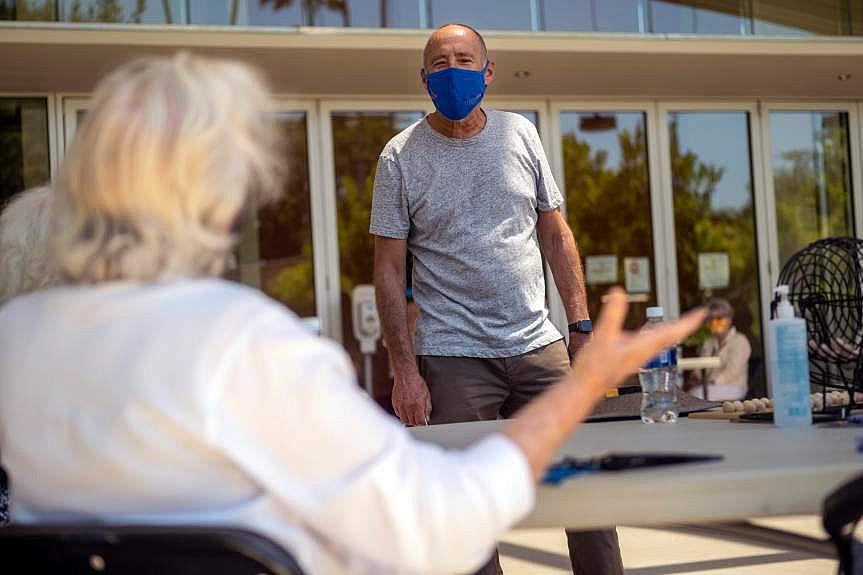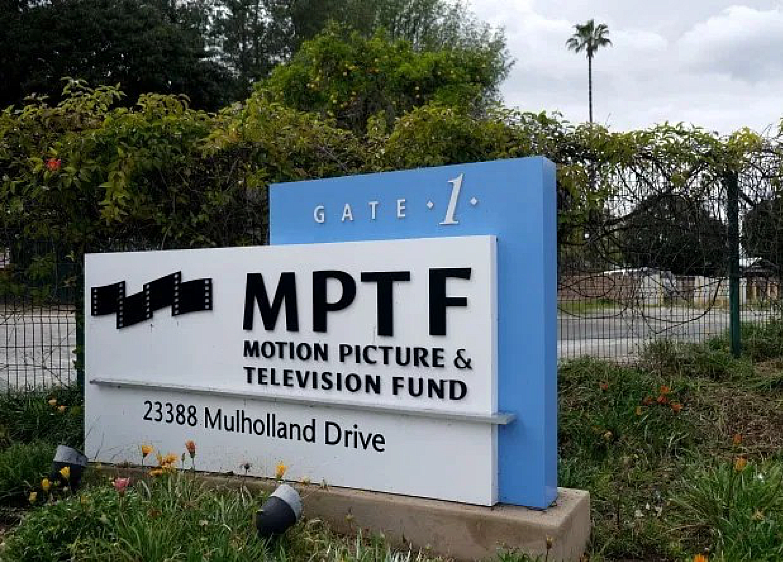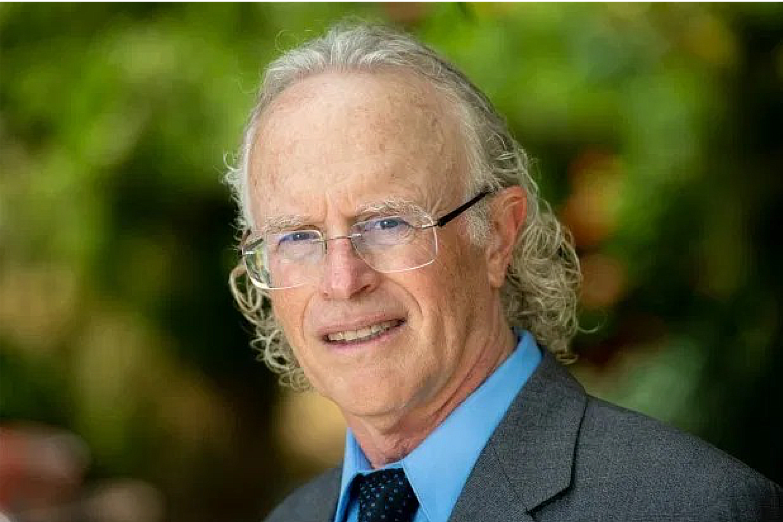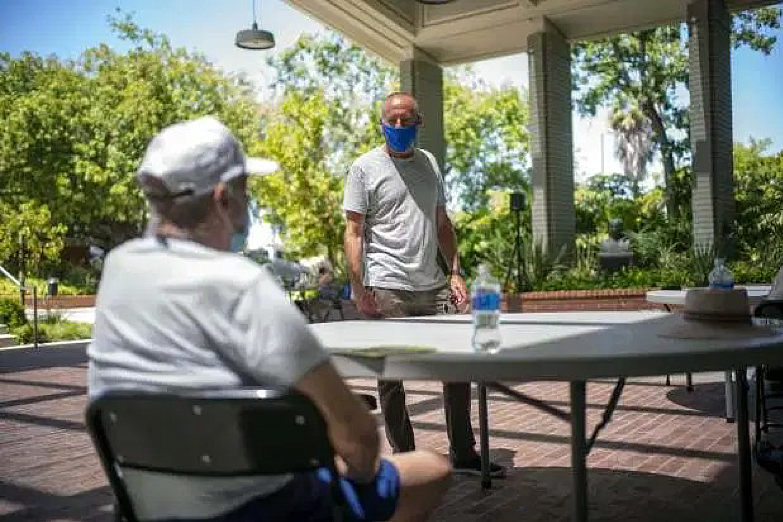'This isn't a drill': How LA's Motion Picture home battled coronavirus
This story was produced as part of a larger project by Brenda Gazzar, a participant in the 2020 California Fellowship.
Her other stories include:
‘Pandemic within a pandemic:’ What’s fueling LA County’s coronavirus death toll in nursing homes?
Known and loved: These six residents of LA’s Motion Picture home died of coronavirus
‘Behind the 8-ball:’ Many Southern California nursing homes hit hard by coronavirus had prior issues
A tale of two Southern California nursing homes in the era of coronavirus
Family of nursing home resident who died: ‘She had 3 really good years there and 1 really bad week’
Social isolation takes toll on Southern California nursing home residents during pandemic holidays
Can California nursing homes avoid the next ‘humanitarian crisis?’
This nursing home ‘angel’ struggled to support her family. Then she got coronavirus…

Bob Beichter, President and CEO of the Motion Picture and Television Fund at the Motion Picture and Television Fund's Wasserman Campus in Woodland Hills, Wednesday, June 10, 2020. (Photo by Hans Gutknecht, Los Angeles Daily News/SCNG)
(Photo by Hans Gutkncht, Los Angeles Daily News/SCNG)
Despite early precautions, administrator Bob Beitcher feared it was a matter of time before the novel coronavirus slipped into his high-profile Motion Picture and Television Fund congregate living facility.
In February, as confirmed cases of COVID-19 mounted in the region, they stockpiled surgical gowns, N95 masks and gloves at the scenic Wasserman Campus in Woodland Hills for entertainment-industry retirees and their spouses, said Beitcher, president and CEO of the MPTF.

They then notified their roughly 225 residents, a mix of independent living, assisted living and skilled nursing residents, that the campus would go into quarantine on March 9.
"You are sheltering in place," Beitcher said of the rules. "No family allowed on campus. Your food will be delivered to your door."
They also began scanning temperatures and questioning workers about any symptoms or travel before they entered.
Days passed, then a few weeks without a known case.
"I went to bed every night praying that the next day wouldn t bring a positive case and woke up every morning praying that this wasn t going to be the day. And then it was," Beitcher said of the first resident to test positive at the end of March.
After that first case, there was a second and then a third. Over the next several weeks, 17 skilled nursing residents and 17 staff members tested positive.
Six of the residents from the Mary Pickford House, a long-term care unit, and Harry s Haven, a dementia unit, died - all in April.

Beitcher is confident the virus was unknowingly carried into the nonprofit home from an asymptomatic caregiver. Caregivers were getting residents sick, he said, and residents were getting caregivers sick.
"You have almost this spiraling, like wildfire," Beitcher said. "By the time you see what s going on, it s too late."
The facility s skilled nursing caregivers started wearing surgical masks about the time the campus went into quarantine, later switching to more protective N95s as the outbreak intensified, he said.
"We took this position early on that we had to assume that everyone had COVID," Beitcher said.
They were ahead of the recommendations.
Face covering debacle
Initially, the U.S. Centers for Disease Control and Prevention advised that only health care workers caring for known or suspected coronavirus cases - along with infected patients - needed to wear masks, Jason Belden, disaster preparedness manager of the California Association of Health Facilities, said.
Early guidance from federal, state and county agencies had urged facilities to conserve personal protective equipment because supplies were limited.
"Now it seems that primary transmission has been from asymptomatic staff and asymptomatic patients being sent from hospitals and not being tested," Belden said. "Both, we were told, were state practice. Those decisions accelerated outbreaks across the country."
The California Department of Public Health noted in late January a report from Germany confirming "that the disease can be transmitted from an asymptomatic individual." That study was later determined to be flawed but other studies in February and March indicated coronavirus could be transmitted by those without symptoms.
In early April, the CDC recommended that everyone wear cloth face coverings in public settings where social distancing is difficult to maintain.
But it wasn t until mid-April that both the CDC and the state s public health department instructed all healthcare workers to wear facemasks at all times in their facilities in an effort to protect residents and staff. Los Angeles County followed suit with a similar directive for skilled nursing facilities later that month. (Staff caring for COVID-19 patients had been told to use N95 masks to protect themselves or if not possible, another facemask.)
Caregivers who were told they didn t need to wear masks earlier in the pandemic "were given extraordinarily bad advice," Michael Connors of California Advocates for Nursing Home Reform said.
State health officials, defending their actions, said the state "acted aggressively on all fronts." They said this included deploying strike teams for at-risk nursing homes and limiting visitors while dealing with "extreme shortages" of tests as well as shortages for personal protective equipment and ventilators.
"We were also dealing with, and continue to manage, a highly contagious virus about which relatively little was known," a spokesperson for the Department of Public Health said by email.
So little testing
The Motion Picture home, like other nursing homes, struggled to get diagnostic testing for residents and staff early on, allowing the stealthy virus to spread unchecked, Beitcher said.

"There was so little testing available and testing was only available for people who were symptomatic - and even then you had to be more than mildly symptomatic to be tested - and at that point, you re probably shedding virus and getting other people sick," Beitcher said.
The home was eventually able to secure more than a thousand test kits largely through L.A. Mayor Eric Garcetti s office, allowing them to test everyone on their 23-acre campus multiple times.
In April, they bought a Biomeme device, enabling them to perform scores of diagnostic tests a day while getting results in less than two hours.
"(It) has been a lifesaver for us," Beitcher said.
Federal, state and county officials have come under fire for not recommending and enabling comprehensive testing in nursing homes sooner.
"The data has been very clear, as early as mid-March, that asymptomatic carriers can bring this into nursing homes," said Dr. Michael Wasserman, president of the California Association of Long Term Care Medicine. "We desperately needed leadership."
Officials have acknowledged challenges - from limited lab capacity to coordination issues - but say they are now in a better place.
Building a testing plan for l,200 nursing homes in the state is "a massive undertaking" requiring trained medical staff with adequate protective equipment and swabs, thousands of tests and a plan when positives are found, state health officials said.
"California now has all these pieces in place," officials said.
In late April, Los Angeles County s public health director, Barbara Ferrer, said her department, which regulates skilled nursing facilities in the county, had been wrong to focus testing around symptomatic people in these facilities and would change strategies.
By early June, 23 percent of the 3l5 such facilities her department directly supports had yet to test all of their residents and staff, Ferrer said. As of June l7, all of these had completed testing.
The Wild West
The Motion Picture home staff didn t realize how much of their personal protective equipment they would "burn through" in a day, Beitcher said.

When supplies dwindled, they scrambled and looked outside of their mainstream suppliers.
Without federal oversight and control, states were bidding against one another, as were hospitals and nursing homes, Beitcher recalled. Price gouging and broken promises were the norm. The facility was forced to pay at least 10 times more for gowns and masks, but he said it was "happy to pay it."
"It really became the Wild West," Beitcher said.
Considering the lack of supplies most nursing homes traditionally have, it s no wonder they are "in the eye of the storm," said Kim Evon of Service Employees International Union Local 2015, which represents nursing home and in-home care workers.
Months into the crisis, some nursing home workers still were being told to reuse surgical masks or to wash cloth ones, she said.
"It s just a history of this industry not being prepared and really lacking supplies," Evon said.
Moreover, the majority of workers in the industry are women and women of color who don t have the luxury of sheltering in place, she said.
Nursing homes typically have a small supply of personal protective equipment because they don t usually deal with large-scale outbreaks of infectious disease, said Belden of the California Association of Health Facilities. When the global supply chain for protective equipment was disrupted, operators turned to unvetted sources and begged others for help.
Political leaders should have enhanced pandemic preparedness and bolstered national and state stockpiles after the U.S. faced equipment shortages and testing problems during the H1N1 influenza pandemic of 2009, but they didn t, said Dr. Tony Iton of the California Endowment, a statewide health foundation.
As a result, society s most vulnerable members, including nursing home residents and workers, security guards and grocery store clerks, were left in harm s way, he said.
"You can judge a society by how it treats its most vulnerable people," Iton said. "(It s) a responsibility of our leaders to listen to public health officials about preparedness."
lnfection control
While there s limited data on the role infection control in nursing homes has played so far in the spread of COVID-19, public health experts say its importance in helping curb infectious diseases is clear.
The ability to conduct surveillance and screening and implement infection control practices around hygiene, cleaning equipment and proper use and adequate supply of personal protective equipment are "all absolutely critical," said Iton, a former Alameda County public health director.
Beitcher agreed that such protocols are "extremely important."
The Motion Picture home s skilled nursing facility has a five-star overall rating on Medicare s Nursing Home Compare website. But like many nursing homes in the region, it was cited for several infection control violations since 2018, according to a ProPublica database of federal data.
They included failure to ensure that a licensed vocational nurse washed their hands and changed gloves during wound treatment for a resident; failure to ensure a stethoscope and blood pressure cuff were disinfected between patients and failure to document washing machine temperatures to ensure proper cleaning and disinfection of laundry.
"We re not perfect," Beitcher said, adding that his skilled nursing staff often works under pressure. "We put together performance improvement plans when that happens and we try to correct those mistakes."
Meanwhile, many skilled nursing residents have some form of cognitive impairment, which often means their behavior is not easily controlled.
"Washing their hands doesn t come to mind" for these residents, Beitcher said. "A lot of them don t like wearing masks. .They don t stay in their rooms."
High and low
When the Motion Picture home announced it was setting up a COVID isolation unit, at least a dozen staff members volunteered to work it, Beitcher said.
Some chose to be away from their family for weeks, living in a hotel or in extra accommodations on campus.
With some testing positive and others opting not to come in, the nursing home searched "high and low" for workers, Beitcher said. The facility relied on temp workers, registries and staff connections to plug the gaps.

Members of the California National Guard, who were deployed to support 20 skilled nursing facilities in need across the state, helped test residents, feed them and answer call lights on campus, Beitcher said.
Nursing homes have had to turn to travel registries, travel nurses and, in some cases, the county and state to help with emergency staffing, Belden of CAHF said. However, the urgency and the need have subsided since everyone in these facilities started wearing masks.
The state upped its staffing requirements for nursing homes in 2018 but most facilities have requested waivers to postpone meeting those responsibilities, the SEIU s Evon said.
While the Motion Picture home ranks high on staffing on Nursing Home Compare, the industry has long been challenged by staff shortages, turnover, high resident-to-staff ratios, supply shortages, and often inadequate infection prevention and control measures, experts say.
Moreover, certified nursing assistants, who give most of the care in these facilities, get paid less than licensed nurses and get less paid sick leave while the complexity of patient care has increased.
"What has happened is the creation of a perfect storm for the COVID-19 pandemic to run wild," said Dean Patricia Davidson of the Johns Hopkins School of Nursing.
Relief
The last resident to test positive at the Motion Picture home was on April 12, Beitcher said. The last worker tested positive on June 1.
"We obviously feel relieved and excited that we can close the unit for now," he said.
Beitcher believes comprehensive testing was critical to identifying infected staff members and sending them home to get better. About a third of infected residents and staff were identified through surveillance testing, while the others presented symptoms, he said.
Going to a higher level of personal protective equipment, as well as isolating sick residents, also were important.
"I d like to think it s a lot of what we did; and a lot of it is luck," Beitcher said.
Throughout the ordeal, he said administrators learned the value of working as a team and listening to workers on the floor, who had the best insights. They also realized how one person s actions, such as not wearing a mask in public or frequently making grocery store visits, can affect so many others in the facility.
"People have wanted to tell me how successful we've been (in managing this crisis), but my definition of success doesn t include losing six residents," he said.
"They are not just residents but friends, people we see every day."
Now, the staff is gearing up for another potential round of COVID-19 and also the flu season, which will further complicate their jobs because symptoms can be similar.
"It s time for us to go into that (isolation) unit. take what we learned in the last month and a half and do what we need to do to get it ready for the second wave; and hope to never have to use it again," Beitcher said.
Staff writers David Rosenfeld and Elizabeth Chou contributed to this report. Gazzar wrote this story while participating in the USC Annenberg Center for Health Journalism's California Fellowship.
[This article was originally published by Los Angeles Daily News.]

